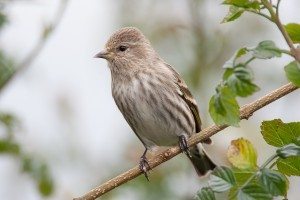Being a good (bird) host
By Phila Rogers
While others are thrilled with Pine Siskins visiting their feeders, I experience mostly foreboding. Several years ago, when the siskins were on the move and visiting my feeders, I began seeing sick birds. The problem then appeared to be a finch eye disease where discharge was effectively sealing up their eyes.
After an absence of several years, Pine Siskins began showing up again at my deck feeders in the Berkeley Hills. Last week, I noticed a lethargic bird, feathers puffed up, who was reluctant to fly off at my approach. Because there appeared to be no discharge around the eyes, I decided that this might be an injured bird suffering from an impact with one of the surrounding windows.
Each time I saw the bird it appeared weaker until finally I discovered it dead in the tray feeder. I tenderly put it in a baggie and then the freezer to give it my birding buddy who volunteers each week at the Lindsay Wildlife Museum.

My injury theory evaporated when I discovered two more sick siskins. Sounding the alarm, I heard first from the birds’ best friend, GGBA field trip leader Rusty Scalf, who in turn put me in touch with the very-knowledgeable Veronica Bowers, director of the Native Songbird Care and Conservation group in Sebastopol. She assured me that I was doing the right thing by bringing in and sterilizing both the feeder and the nearby bird bath. My Google search indicated that the birds were probably the victims of an outbreak of salmonella, which Veronica says is hard to treat.
The worst news for me – an ardent window-watcher — was that I shouldn’t rehang the feeder for at least two weeks because of the highly contagious nature of the disease.
This sad tale got me to thinking about the responsibilities we take on when we feed birds. Because our feeders encourage congregations of birds, communicable diseases are more easily spread. If seed is allowed to get wet, mildewed seed can make birds sick. Also seed attracts unwanted guests like squirrels, rats, and even skunks. Roaming cats attuned to congregating birds can extract their toll,
So here’s my strategy: Once I rehang my feeder, I will bring in the feeder each night and sweep up scattered seed to discourage rat visits, and following Veronica’s suggestion, buy another feeder or two so I can change and sterilize them regularly. Oh yes, I’ll keep the bird bath scrubbed and replace water regularly. Also, I’ll let my neighbors with their free-roaming cats know that if their cat catches one of the diseased bird, they, too, may contract the disease.
So I have a week and a half to go before I (tentatively) rehang the feeder. In the meantime, I’m going “cold turkey,” hoping that memory alone will continue delivering a few birds to my deck.
—————————-
Want more info on maintaining safe and healthy feeders? See this web page by the California Department of Fish and Game, or this one by National Audubon Society. The Cornell Lab of Ornithology has an online booklet that gives a good overview of bird feeding, from different kinds of seed and feeders to safe maintenance.
